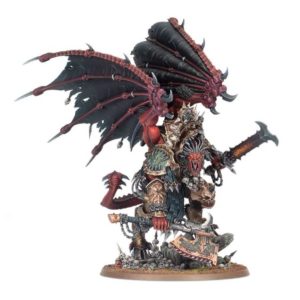Step 1: Primer for a Strong Base
Applying a primer, such as Wraithbone, to your miniature is a crucial first step. The primer creates a solid foundation for your paints to adhere to, ensuring better color payoff and longevity. It also helps the subsequent layers of paint stick better, preventing chipping and flaking. Allow the primer to dry thoroughly before moving on; this usually takes around 15-30 minutes depending on the weather and humidity.
Step 2: Chitin Armor Base Coat
Using Naggaroth Night, begin coating the chitin armor of your Norn Emissary. Aim for smooth and even coverage, applying thin layers to avoid obscuring the fine details. Keep your brush strokes consistent and controlled. It’s better to use multiple thin layers than one thick layer, as this helps maintain the model’s intricate textures.
Step 3: Shading for Depth
Now, introduce depth and contrast to the chitin armor by applying Nuln Oil to the recessed areas. This shade will settle into the crevices, adding shadows that bring out the three-dimensional aspect of the miniature. Use a fine-tipped brush for precision, ensuring that the shade does not spill onto areas you want to remain bright.
Step 4: Lighten with Layering
Using Xereus Purple, delicately layer the raised portions of the chitin armor. This layering technique enhances the visual transition from shadow to light, creating a gradual gradient. Take your time with this step, focusing on smooth blends between the different color layers. Patience pays off here, as the result will be a more realistic and visually appealing texture.
Step 5: Highlight the Edges
With Slaanesh Grey, carefully highlight the edges of the armor plates. This edge highlighting simulates the way light naturally interacts with surfaces, making the model’s armor stand out even more. Concentrate on the edges that would catch the most light, giving the miniature a striking and dynamic appearance.
Step 6: Skin Base Coat
Transitioning to the skin, switch to Pallid Wych Flesh. Prior to applying the paint, thin it slightly with water to achieve smoother application. Begin with a light base coat, covering the skin areas evenly while maintaining the natural contours of the miniature’s anatomy.
Step 7: Shading for Skin Depth
Enhance the realism of the skin by applying Druchii Violet to the recesses and folds. This adds depth to the skin texture, making it look more lifelike. By focusing the shade in the areas where shadows would naturally gather, you create a more believable and three-dimensional effect.
Step 8: Layering for Skin Texture
Using pure Pallid Wych Flesh, gently layer the raised portions of the skin. This layering step introduces depth and texture to the skin, making it appear more organic and natural. As with the armor, take care to create smooth transitions between layers to achieve the best visual result.
Step 9: Highlight the Skin
Use White Scar to accentuate the most prominent points of the skin, such as the cheekbones and knuckles. These highlights simulate where light directly hits the skin, drawing attention to these areas and emphasizing the model’s facial features.
Step 10: Detail the Spikes or Horns
For the red spikes or horns, select Mephiston Red. Apply the color with precision, ensuring not to spill onto the armor or skin areas. The red details add contrast and visual interest to the miniature’s overall appearance.
Step 11: Final Touches
Examine your work closely and address any imperfections or inconsistencies. Use a fine brush to refine the finer details and make any necessary touch-ups. This step is your opportunity to fine-tune the model before considering it complete.
Step 12: Optional Varnish
If you want to protect your hard work, consider applying a varnish. This can safeguard the paint job from wear and tear, as well as potential damage. Select a matte, satin, or gloss varnish based on your desired finish. Applying varnish is particularly recommended if you plan on using the miniature for gaming, as it can help maintain the quality of your paintwork over time. We suggest Munitorum Varnish Spray for this step.



